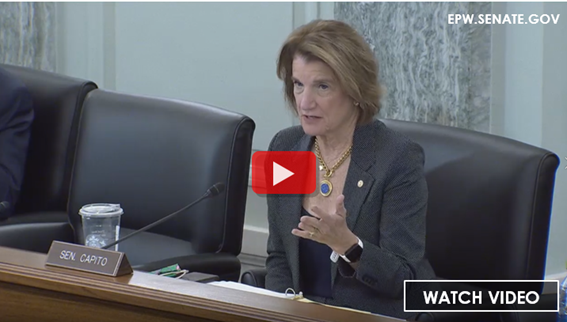
To watch Senator Capito’s questions, click here or on the image above.
WASHINGTON, D.C. – U.S. Senator Shelley Moore Capito (R-W.Va.), Ranking Member of the Senate Environment and Public
Works (EPW) Committee, today questioned Shannon Estenoz, nominee to be
Assistant Secretary of Fish and Wildlife and Parks of the Department of
Interior (DOI); Radhika Fox, nominee to be Assistant Administrator for Water of
the Environmental Protection Agency (EPA); and Michal Freedhoff, nominee to be Assistant
Administrator for Chemical Safety and Pollution Prevention of EPA.
HIGHLIGHTS:
ON WOTUS: “We talked about this issue on Waters of the U.S.,
and you’ve all pledged clarity and thoughtfulness and regulatory certainty.
Administrator Regan committed to not going back to a verbatim reading of the
2015 Obama Waters of the U.S. Rule. This is a very far-reaching rule that
impacts a lot of people, a lot of agriculture as well. But he hasn’t provided
much more detail on this. So I’m wondering, in your opinion, do you believe the
2015 rule was overreaching? What would your plans to ensure we do not return to
that overreaching definition, which I obviously believe that it was? And also
you agree or disagree with the court decisions, including injunctions, against
that rule that were issued in 2015?”
ON NEPA & PERMITTING
REFORM: “Ms. Estenoz, I wanted to ask
you about NEPA (National Environmental Policy Act). Just recently,
Secretary Haaland signed Secretarial Orders that directed DOI to ignore and not
follow the commonsense reforms to implementation of NEPA. We hear about this
from everybody in terms of how long it takes things to get approved, how long
the process is, how lengthy and expensive it is. We still are having issues. So
did you play any role in advising Secretary Haaland on NEPA implementation
decision? Are there any elements of the Trump administration’s NEPA reforms
that you could support?”
ON PFAS: “You know that this is something I’m deeply committed
to, and you mentioned it in your opening statement. Do you feel like there’s a
scientific gap in the tools that EPA needs to decide whether and how to
regulate [PFAS]? It seems like it’s taken so long in some ways. Is that because
there’s a gap in tools and a gap in certifiable data that can be used moving
forward?”
# # #